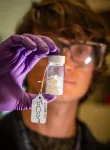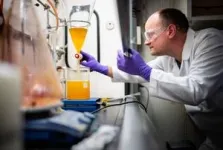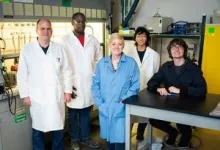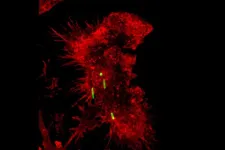(Press-News.org) ALBUQUERQUE, N.M. — A team at Sandia National Laboratories developed a molecule that helps change the way some materials react to temperature fluctuations, which makes them more durable. It’s an application that could be used in everything from plastic phone cases to missiles.
Polymers, which include various forms of plastics, are made up of many smaller molecules, bonded together. This bond makes them especially strong and an ideal product to be used to protect delicate components in a wide variety of items. But with time, use and exposure to different environments, all materials begin to deteriorate.
Hot to cold, cold to hot, the big problem
One of the biggest factors in materials deterioration is repeated exposure from hot to cold temperatures and back. Most materials expand when heated and contract when cooled, but each material has its own rate of change. Polymers, for example, expand and contract the most, while metals and ceramics contract the least.
Erica Redline, a materials scientist who leads the team, said most items are made up of more than one kind of material.
“Take for example, your phone, which has a plastic housing, coupled to a glass screen, and inside that, the metals and ceramics that make up the circuitry,” Redline said. “These materials are all screwed, glued or somehow bonded together and will start expanding and contracting at different rates, putting stresses on one another which can cause them to crack or warp over time.”
Redline said she kept hearing the same complaint from Sandia’s many customers.
“They’re always talking about thermal expansion mismatch problems and how their existing systems are hard to work with because of all the filler they need to add to compensate,” Redline said.
With that, Redline’s idea was born.
“I thought, what if I conjured up a perfect material, what would that look like,” Redline said.
Redline thinks she’s done it, with the help of her team Chad Staiger, Jason Dugger, Eric Nagel, Koushik Ghosh, Jeff Foster, Kenneth Lyons, Alana Yoon and academic alliance collaborators Professor Zachariah Page and graduate student Meghan Kiker.
The molecule in action
The team modified a molecule so that it can easily be incorporated into a polymer to change its properties.
“This really is a unique molecule that when you heat it up, instead of it expanding, it actually contracts by undergoing a change in its shape,” Redline said.
“When it’s added to a polymer, it causes that polymer to contract less, hitting expansion and contraction values similar to metals. To have a molecule that behaves like metal is pretty remarkable.”
Endless possibilities
This molecule could be used in endless ways. Polymers are used as protective coatings in electronics, communications systems, solar panels, automotive components, printed circuit boards, aerospace applications, defense systems, flooring and more.
“The molecule not only solves current issues but significantly opens up design space for more innovations in the future,” said Jason Dugger, a Sandia chemical engineer who has been looking at potential applications, especially in defense systems.
Another key to this invention is that it can be incorporated into different parts of a polymer at different percentages, in 3D printing.
“You could print a structure with certain thermal behaviors in one area, and other thermal behaviors in another to match the materials in different parts of the item,” Dugger said.
Another benefit is helping reduce the weight of materials by eliminating heavy fillers.
“It would enable us to do things much lighter to save mass,” Dugger said. “That is especially important when launching a satellite, for example. Every gram we can save is huge.”
Redline said she has also been approached by an epoxy formulator who believes this molecule could be incorporated into adhesives.
The next step
The team has only created this molecule in small quantities, but they are working to find a way to scale up production so that other Sandia researchers can test the molecule to fit mission needs.
Chad Staiger, an organic chemist at Sandia, makes the molecule. He said it takes him about 10 days to make between 7-10 grams.
“It’s unfortunately a long synthesis for this molecule,” Staiger said. “More steps equal more time and more money. You usually see five- to six-step syntheses in higher value materials such as pharmaceuticals. In polymers, the cheaper the better for wide scale adoption.”
The team is working to reduce the steps using $100,000 in funding through Sandia’s technology maturation program, which helps ready products for the marketplace.
“My role is to see if there is an easier way to make it at a commercial level,” said postdoc Eric Nagel. “There is nothing like it out there. I am really excited at the possibilities of what this technology can do and the applications that could be associated with this.”
“It’s pretty phenomenal and pretty wide open,” Staiger said.
Dugger agreed: “It really is a sky’s the limit kind of thing.”
END
Making materials more durable through science
Sandia researchers develop molecule that reduces wear and tear
2023-08-24
ELSE PRESS RELEASES FROM THIS DATE:
New framework for oceanographic research provides potential for broader access to deep sea scientific exploration
2023-08-24
Woods Hole, Mass. (August 23, 2023) -- Scientific exploration of the deep ocean has largely remained inaccessible to most people because of barriers to access due to infrastructure, training, and physical ability requirements for at-sea oceanographic research.
Now, a new and innovative framework for oceanographic research provides a way for shore-based scientists, citizen scientists, and the general public to seamlessly observe and control robotic sampling processes.
The Shared Autonomy for Remote Collaboration (SHARC) framework “enables remote participants to conduct shipboard operations and control ...
How pre-eclampsia accelerates aging in women
2023-08-24
ROCHESTER, Minnesota — Pre-eclampsia, a life-threatening surge in blood pressure, is an enigmatic condition. Each year, it causes the deaths of more than 70,000 women worldwide. Because scientists do not know what causes it, they lack targeted strategies to treat it.
Delivery, the only available therapy, is not the cure it is often made out to be, according to Vesna D. Garovic, M.D., Ph.D., a nephrologist at Mayo Clinic in Rochester, Minnesota, who has devoted her career to studying this common pregnancy complication.
"Even after delivery, women ...
Sweet corn yield at the mercy of the environment, except for one key factor
2023-08-24
URBANA, Ill. — A new analysis from the University of Illinois Urbana-Champaign and the USDA-Agricultural Research Service (ARS) has identified the top factors accounting for yield variability in processing sweet corn (used for canned and frozen products), including one within the control of processors.
“We used a very robust approach to account for sweet corn yield with field-level data across some 16,000 fields and 27 years. Year and production region were the two most important variables, which makes ...
Cambridge and ISPA scientists create a tool to identify individuals at risk of developing different myeloid leukemias
2023-08-24
Scientists have created a new test for identifying people at risk of developing acute myeloid leukaemia and related cancers, years before they do. The new platform, ‘MN-predict’, will allow doctors and scientists to identify those at risk and to design new treatments to prevent them from developing these potentially lethal cancers.
Researchers at the Wellcome-MRC Cambridge Stem Cell Institute (CSCI), the University of Cambridge’s Department of Haematology, and Instituto de Investigación Sanitaria del Principado de Asturias (ISPA) analysed data from more than 400,000 individuals participating ...
Repairing broken brain circuits may offer path to new Parkinson’s treatments
2023-08-24
GRAND RAPIDS, Mich. (August 24, 2023) — Van Andel Institute scientists have identified a series of processes that help the brain adapt to damage caused by breakdowns in circuits that govern movement, cognition and sensory perception.
Because such breakdowns contribute to Parkinson’s disease, the findings may one day help researchers optimize current treatments or develop new ones that repair or bypass the broken circuits.
A study describing the findings published this week in the journal Science Advances.
“Our work highlights the importance ...
MSK Research Highlights, August 24, 2023
2023-08-24
New research from Memorial Sloan Kettering Cancer Center (MSK) and the Sloan Kettering Institute — a hub for basic science and translational research within MSK — suggests a method for revealing DNA repair “scars” could help make treatment decisions in BRCA1- and BRCA2-deficient cancers; modified a bacteria-made compound to target mutant KRAS-driven cancers; and shed new light on brain metastasis in non-small cell lung cancer.
New method for revealing DNA repair “scars” ...
Study uncovers genetic risk factors for heart failure
2023-08-24
In a new study co-led by investigators at the United States Department of Veterans Affairs and Brigham and Women’s Hospital, a founding member of the Mass General Brigham healthcare system, a global team of scientists conducted one of the largest genetic association studies on heart failure to date. Using genomic data from over 90,000 heart failure patients and more than a million controls, the team identified 39 genetic mutations associated with heart failure, 18 of which had not been reported previously.
The researchers also pinpointed seven druggable proteins that, when targeted with specially ...
Training immune cells to remove ‘trash’ helps resolve lung inflammation
2023-08-24
Inflammation is a standard part of our bodies’ immune system response. But sometimes this response becomes hyperactivated in our lungs, causing inflammation to continue unchecked, which can be fatal. Many deaths from COVID-19 have been due to excessive inflammation, which results in acute lung injury.
A group of researchers at the University of Illinois Chicago have investigated how lungs counterbalance inflammation. Their work points to cells in the lung that reduce inflammation by removing ...
A new pathway to regenerate myelin discovered
2023-08-24
A study led by Dr. Hyun Kyoung Lee, associate professor at Baylor College of Medicine and investigator at the Jan and Dan Duncan Neurological Research Institute at Texas Children’s Hospital, has discovered a new biological mechanism to regenerate and repair myelin, a protective sheath that insulates neuronal fibers and plays a vital role in ensuring rapid and accurate neurotransmission. The Duncan NRI team found novel roles for the Dishevelled associated activator of morphogenesis 2 (Daam2) protein and CK2α kinase in regulating myelin repair and regeneration. The study was published in the Proceedings of the National ...
Monell Center helps discover epigenetic mechanism that causes bitter taste distortion
2023-08-24
PHILADELPHIA (August 24, 2023) – A bitter taste in the mouth is often a symptom or side effect of illness, which may be the result of how the body reacts to pathogens. A new study published in iScience, by Hong Wang, PhD, an Associate Member at the Monell Chemical Sense Center, and colleagues sheds light on the mechanisms involved in the complex interplay between taste perception and immune function. Their work also highlights the potential of a sequencing tool for investigating epigenetic mechanisms that affect taste-cell gene expression. Epigenetics is the study of how and when genes are expressed rather than alteration of the genetic ...
LAST 30 PRESS RELEASES:
Structure of dopamine-releasing neurons relates to the type of circuits they form for smell-processing
Reducing social isolation protects the brain in later life
Keeping the heart healthy increases longevity even after cancer
Young adults commonly mix cannabis with nicotine and tobacco
Comprehensive review illuminates tau protein's dual nature in brain health, disease, and emerging psychiatric connections
Book prepares K-12 leaders for the next public health crisis
Storms in the Southern Ocean mitigates global warming
Seals on the move: Research reveals key data for offshore development and international ecology
Sports injuries sustained during your period might be more severe
World's first successful 2 Tbit/s free-space optical communication using small optical terminals mountable on satellites and HAPS
Can intimate relationships affect your heart? New study says ‘yes’
Scalable and healable gradient textiles for multi‑scenario radiative cooling via bicomponent blow spinning
Research shows informed traders never let a good climate crisis go to waste
Intelligent XGBoost framework enhances asphalt pavement skid resistance assessment
Dual-function biomaterials for postoperative osteosarcoma: Tumor suppression and bone regeneration
New framework reveals where transport emissions concentrate in Singapore
NTP-enhanced lattice oxygen activation in Ce-Co catalysts for low-temperature soot combustion
Synergistic interface engineering in Cu-Zn-Ce catalysts for efficient CO2 hydrogenation to methanol
COVID-19 leaves a lasting mark on the human brain
Scientists use ultrasound to soften and treat cancer tumors without damaging healthy tissue
Community swimming program for Black youth boosts skills, sense of belonging, study finds
Specific depressive symptoms in midlife linked to increased dementia risk
An ‘illuminating’ design sheds light on cholesterol
Who is more likely to get long COVID?
Study showcases resilience and rapid growth of “living rocks”
Naval Research Lab diver earns Office of Naval Research 2025 Sailor of the Year
New Mayo-led study establishes practical definition for rapidly progressive dementia
Fossil fuel industry’s “climate false solutions” reinforce its power and aggravate environmental injustice
Researchers reveal bias in a widely used measure of algorithm performance
Alcohol causes cancer. A study from IOCB Prague confirms damage to DNA and shows how cells defend against it
[Press-News.org] Making materials more durable through scienceSandia researchers develop molecule that reduces wear and tear






